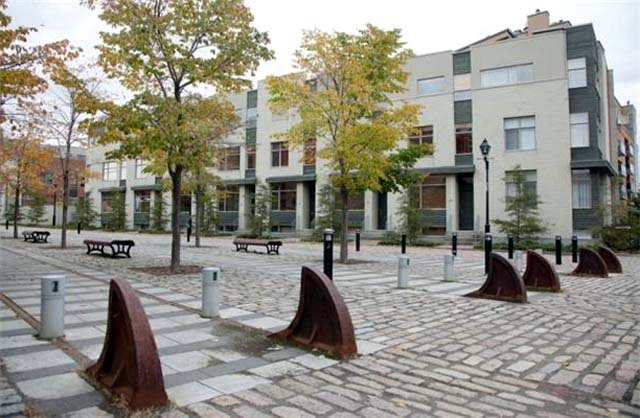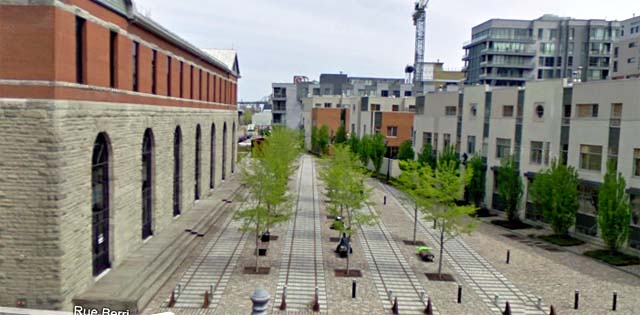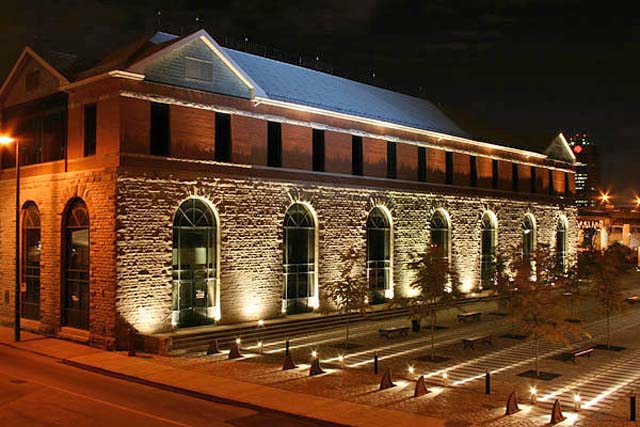
2012
|


Dalhousie Square has recently been restored. It includes a series of imitation train tracks put in place as a
tribute to the historic vocation of the old site - Date unknown Vincenzo D'Alto.
13 October 2012
Dalhousie Square Rises from the Ashes
Montreal Quebec - After years of benign neglect, Dalhousie Square has recently been restored. Today, in fact, it is fast becoming the
centre of a stunning contemporary urban redevelopment that has given rise to an entire new neighbourhood situated just east of Old Montreal in Faubourg Quebec.
Residents of this new locality are indeed living in the midst of history.
In the middle of the 19th century, Dalhousie Square was as prestigious an address as any in the city. Then came 8 Jul 1852. On that unfortunate day, more than
one-third of our burgeoning town was destroyed by fire, including most of Dalhousie Square. Several period paintings depict the loss of Hays' House, one of
Montreal's finest hotels located on that very site.
On the southern flank of the same plaza, overlooking the St. Lawrence River, was found a military compound, including the soldiers' barracks, both of which
affirmed the formidable British armed presence in this city. The withdrawal of these colonial forces in 1871 left a tremendous void in the daily life of
Dalhousie Square, as well as Montreal as a whole.
A decade later, the square was further compromised with the construction of the Dalhousie train station, which has stood, since 1883-84, on the southeast
corner of Notre Dame and Berri Streets. It was from this depot that the pioneer CPR train left for Vancouver on what was the first transcontinental train trip
in North America.
Five years later, that same high-windowed, stone-and-brick structure, lost much of its significance with the official opening of Windsor Station in the city's
west end. Then it was further slighted when the CPR inaugurated in 1898 at Viger Square a much larger hotel and station complex, one block north of the
Dalhousie depot. From that moment on, period photos show a vast network of railway tracks running from Craig Street (St. Antoine Street today) all the way down
to the St. Lawrence River.
As the years passed, Dalhousie Station settled into relative obscurity, although it was still used as late as the Second World War when soldiers were often
sent down east to Halifax for eventual deployment to Europe.
Today's reconfigured Dalhousie Square, like the old one, stands between Berri and Street Hubert Street, immediately south of Notre Dame.
During a recent walk through the revitalized neighbourhood, I was struck by several features. First, Dalhousie Station has been thoroughly refurbished to its,
albeit brief, glory days. Today, it is home to the Eloize Circus, a leader in contemporary circus arts since its establishment in 1993. There are two
entrances: one from the Notre Dame viaduct and the other from Berri below.
To the south of the now dazzling edifice can be found a series of imitation train tracks put in place as a tribute to the historic vocation of the old site.
Here, if you wander east through the rest of the newly arranged and attractive square, one can see under the Notre Dame flyover, one of the only surviving
portions of the aged, massive Montreal fortifications, most of which was demolished in the early 19th century. For the longest time, it was used as a support
for the old Notre Dame overpass.
Further east can be seen the vast modern urban expansion known as the Faubourg Quebec, and, of course, in the distance, the imposing Jacques Cartier Bridge.
While there, do check out Jocelyne Alloucherie's sculpture Porte de jour and, despite its name, if possible, visit at night when the whole award-winning site
becomes almost magical.
Robert N. Wilkins.

Dalhousie Square - Date/Photographer unknown.

Dalhousie Station - Date/Photographer unknown.

|


|
Vancouver Island
British Columbia
Canada
|
|




